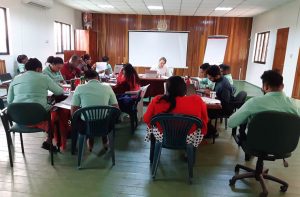THE Environmental Protection Agency (EPA) in collaboration with the World Wildlife Fund (WWF) Guianas – Guyana Country Office and the Netherlands Commission for Environmental Assessment successfully executed a training workshop on Environmental Impact Assessment (EIA) during November 5-8, 2019. The workshop which was facilitated by two experts, Mr. Stephen Teeuwen and Mr. Peter Nelson from the Netherlands Commission on Environmental Assessment aimed at building capacity of environmental regulators to strengthen the administration and review of the EIA/ESIA. Approximately, forty (40) professionals, comprising of 35 EPA staff, along with representatives from the Environmental Assessment Board (EAB) and the Guyana Geology and Mines Commission (GGMC) were beneficiaries of the training.
 Important components covered during the training included: the value of EIA; importance and principles of EIA review; and formulating feedback and permit conditions, amongst others. The training exercise also saw the principles being applied to review some active EIAs engaging the attention of the EPA. Further, the process facilitated review and strengthening of pertinent existing guidelines within the EPA for finalisation.
Important components covered during the training included: the value of EIA; importance and principles of EIA review; and formulating feedback and permit conditions, amongst others. The training exercise also saw the principles being applied to review some active EIAs engaging the attention of the EPA. Further, the process facilitated review and strengthening of pertinent existing guidelines within the EPA for finalisation.
What is an Environmental Impact Assessment (EIA)?
Environmental Impact Assessment (EIA) also referred to as Environmental and Social Impact Assessment (ESIA) is the evaluation of the environmental and socio-economic impacts likely to raise from a major project. It is the process of identifying, predicting, evaluating and mitigating the biophysical, social, and other relevant effects of development proposals prior to major decisions are taken and commitments made. (IAIA, 1999)
What are some areas covered by an EIA?
The EIA/ESIA should identify, describe, and evaluate the direct and indirect effects of the proposed project on the environment including:
* Human beings;
* Plants, animals, species, habitat;
* Soil;
* Water;
* Air and climatic factors;
* Material assets, cultural heritage, and the landscape;
* Natural resources etc.
An important component of the EIA is an outline of the main alternatives studied by the developer and an indication of the main reasons for his/her choice, taking into account the environmental factors.
Some projects requiring EIA
* Construction of roads, harbours and airfields.
* Installation for the treatment of wastewater, industrial or domestic waste.
* Importation of any waste matter whether hazardous or not.
* The release, use or keeping of any genetically modified organisms
* The harvesting and utilisation of forest resources
* The extraction and conversion of mineral resources
Decision to issue Environmental Permit
A decision by the Agency to issue an Environmental Permit for a project shall be subjected to conditions which are reasonably necessary to protect human health and the environment and each environmental permit shall contain specific terms and conditions.
You can share your ideas and questions by sending letters to: “Our Earth, Our Environment”, C/O ECEA Programme, Environmental Protection Agency, Ganges Street, Sophia, GEORGETOWN, or email us at: eit.epaguyana@gmail.com or follow us on Facebook and Instagram












